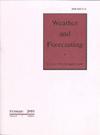Biases and Skill of Four Two-Moment Bulk Microphysics Schemes in Convection-Allowing Forecasts for the 2018 Hazardous Weather Testbed Spring Forecasting Experiment Period
IF 3.1
3区 地球科学
Q2 METEOROLOGY & ATMOSPHERIC SCIENCES
引用次数: 0
Abstract
A proof-of-concept systematic evaluation of convective hazards is applied to short-term (1-6 h) forecasts using the Morrison, National Severe Storms Laboratory (NSSL), Predicted Particle Properties (P3), and Thompson two-moment microphysics schemes for the 2018 NOAA Hazardous Weather Testbed Spring Forecasting Experiment (HWT SFE) period (hereafter “MORR”, “NSSL”, “P3”, and “THOM” experiments, respectively). Four convective line cases are highlighted to elaborate on relative experiment biases/skill. Composite reflectivity and 1-h accumulated precipitation are examined to determine storm coverage/precipitation biases/skill utilizing point-based verification with a neighborhood. Simulated 1-6 km updraft helicity and observed 3-6 km azimuthal shear, and MESH are examined to consider simulated rotation and hail core prediction with object-based scores. Over the full season, MORR displays little overall storm coverage bias relative to NSSL, P3, and THOM underprediction. The equitable threat score (ETS) and fractions skill score (FSS) of P3 are lower than the other experiments. P3 and THOM underpredict convective regions with intense reflectivity relative to MORR and NSSL overprediction. All experiments underpredict precipitation amounts. P3 light precipitation FSS is lower than other experiments. Rotation object verification exhibits sensitivity to microphysics experiments, as microphysics has an indirect influence on storm dynamics. While P3 has the largest hail object underprediction, all experiments grossly overpredict the number of hail objects in convective line cases despite forecast objects defined with the same product (MESH) and threshold as observations. The importance of microphysics ice parameterization and ongoing scheme updates highlight the need to apply this verification framework to optimal/updated schemes before optimizing ensemble design.2018年危险天气试验台春季预报试验期对流容许预报中四种二矩体微物理方案的偏误与技巧
对流危害的概念验证系统评估应用于短期(1-6小时)预报,使用Morrison,国家强风暴实验室(NSSL),预测粒子特性(P3),和Thompson 2018年NOAA危险天气试验台春季预测实验(HWT SFE)期间的两个矩微物理方案(以下分别为“MORR”、“NSSL”、“P3”和“THOM”实验)。重点介绍了四个对流线案例,以详细说明相对实验偏差/技能。利用邻域的基于点的验证,检查复合反射率和1小时累积降水量,以确定风暴覆盖率/降水偏差/技能。对模拟的1-6km上升气流螺旋度和观测的3-6km方位角剪切以及MESH进行了检查,以考虑基于对象的分数的模拟旋转和冰雹核心预测。在整个季节,相对于NSSL、P3和THOM的预测不足,MORR几乎没有显示出总体风暴覆盖偏差。P3的公平威胁得分(ETS)和分数技能得分(FSS)低于其他实验。P3和THOM对MORR和NSSL超预测具有强反射率的对流区的预测不足。所有实验都低估了降水量。P3光沉淀FSS低于其他实验。旋转物体验证对微物理实验表现出敏感性,因为微物理对风暴动力学有间接影响。虽然P3的冰雹物体预测不足最大,但在对流线情况下,所有实验都严重高估了冰雹物体的数量,尽管预测物体的定义与观测值的乘积(MESH)和阈值相同。微物理冰参数化和正在进行的方案更新的重要性突出表明,在优化总体设计之前,需要将该验证框架应用于优化/更新方案。
本文章由计算机程序翻译,如有差异,请以英文原文为准。
求助全文
约1分钟内获得全文
求助全文
来源期刊

Weather and Forecasting
地学-气象与大气科学
CiteScore
5.20
自引率
17.20%
发文量
131
审稿时长
6-12 weeks
期刊介绍:
Weather and Forecasting (WAF) (ISSN: 0882-8156; eISSN: 1520-0434) publishes research that is relevant to operational forecasting. This includes papers on significant weather events, forecasting techniques, forecast verification, model parameterizations, data assimilation, model ensembles, statistical postprocessing techniques, the transfer of research results to the forecasting community, and the societal use and value of forecasts. The scope of WAF includes research relevant to forecast lead times ranging from short-term “nowcasts” through seasonal time scales out to approximately two years.
 求助内容:
求助内容: 应助结果提醒方式:
应助结果提醒方式:


